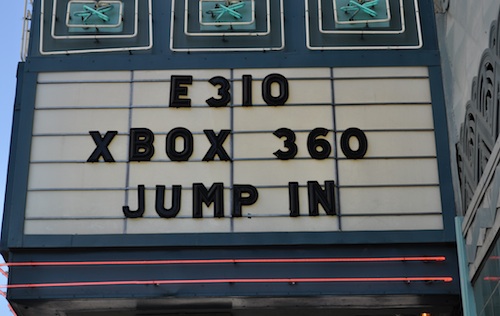
Microsoft has moved to claim the high ground for its Xbox 360 line-up ahead of the official opening of the Electronic Entertainment Expo (E3) on Tuesday in Los Angeles by announcing launch details for its “Project Natal” motion-controlled interface at two separate press events.
The software giant told expo delegates that its motion-sensing camera will be branded as Kinect and will launch in November this year. Kinect can track a user’s body movements to simulate a wide range of actions — from throwing a ball to jumping over hurdles or swinging a light sabre. It can also respond to basic voice commands.
The product launch is an attempt to make gaming more accessible and approachable for people who have no experience with traditional games controllers. It’s also an attempt to expand the Xbox 360’s audience beyond core gamers.
The Kinect announcements come at a time that Microsoft’s Xbox 360 business is in the middle of a transition. J Allard and Robbie Bach, two of the main architects behind the 360, have left Microsoft. Bungie, the developer of Halo, has struck out on its own and is developing a new multiplatform franchise for Activision. And the 360’s sales growth has flattened out after a few years of robust performance.
Though Microsoft has conquered the lucrative hardcore gaming market — made up mostly of young, male gaming enthusiasts aged 18-35 — it must tap into the casual gaming market that Nintendo dominates with the Wii if it is grow sales of the Xbox 360. It must do so in the face of competition from Sony, which has the same goal in mind for its PlayStation Move product.

The Xbox 360 has a commanding lead over the PlayStation 3 in North America and has done reasonably well in most other English-speaking markets. But it has fallen behind the PS3 in many parts of Europe and continues to struggle in Japan. And Nintendo has nearly sold as many Wiis as Sony and Microsoft have sold of their current-generation consoles combined.
An event on Sunday that focused exclusively on Kinect left most attendees scratching their heads. It was an artsy, conceptual affair that roped in more than 70 Cirque du Soleil acrobats and street entertainers for a demonstration of the Kinect technology. After spending two hours milling around waiting for the doors to open, journalists, bloggers, and analysts were herded into the venue and made to wear white ponchos.
A pre-recorded narrator warbled on about how complex life has become after 5m years of evolution. Tribal drums pounded, a 2,7m elephant puppet swirled the stage, and circus performers cartwheeled, tied themselves into knots and clowned about.
“History is about to be rewritten,” intoned the voiceover, just in case anyone thought they were merely witnessing the launch of an accessory for a videogame system. Microsoft then launched into a bunch of games demos that seemed rather similar to the games one can already play on the Wii.
Most of the journalists in the audience didn’t seem impressed, but bringing a casual gaming product to E3 is a bit like taking Britney Spears to play at the Donington heavy metal festival. Use of all technology was banned at the event, but that didn’t stop gaming journos and bloggers from covertly sending snide tweets throughout its running time.
“Guys, you can take the ponchos off, it’s called Kinect and it has Wii Sports. We know already,” tweeted Ben Kuchera, gaming editor of Ars Technica.
But Microsoft doesn’t care what the traditional 360 audience thinks about Kinect. It cares what Middle America, Middle England, Middle Europe, those mythical marketing lands of perky nuclear families, will think about the product. (It’s telling that the early heads-up on the event went to USA Today rather than to one of the big gaming sites or magazines.)
Its success will hinge on how well it’s marketed, how much it can differentiate itself from Sony’s Move and Nintendo’s Wii, how good the games are, and how well it really works in practice. Price will also be important. Microsoft has not yet disclosed pricing, but rumours have placed the cost at up to $150, which might be pricy for casual gamers.
History is stacked against Kinect (and Sony’s Move, for that matter) being a mass-market success. Few peripherals that don’t come bundled with a console from its launch get the critical mass of users that they need for games to sell well enough to justify the cost of making them.
It takes a genuine killer app, such as Guitar Hero or Wii Fit, to propel a new controller into the mainstream. Among the 15 games Microsoft has lined up for the Kinect launch, only one or two may qualify as real killer apps.
Until more people have experienced Kinect’s technology in the real world, it’s hard to say how well it works. Early reports suggest that’s not as precise as Move, but arguably, it doesn’t need to be for casual gaming. Judging from the demos, playing some of Kinect’s games will be hard work, even for people who are relatively fit.

The hurdle-race in Kinect Sports and the river rafting in Kinect Adventures both look like they’ll leave players drenched in sweat after a 30-minute session. It sounds daunting if you’re used to immersing yourself in Halo 3 or Mass Effect 2 for hours on end. Soccer moms who fret about the amount of time junior spends vegetating in front of his console will probably be among Kinect’s biggest fans.
But the single biggest problem with Kinect is just how uninspired Microsoft’s first-party games for the technology are. They’re one-for-one ripostes to the biggest sellers in Nintendo’s catalogue. There’s a Wii Sports clone called Kinect Sports — bet the marketing team earned overtime for that name – and a reply to Mario Kart called Kinect Joy Ride.
Kinectimals, meanwhile, is a cute pet simulator aimed at children that takes its cues from Nintendogs and Sony’s Eyepet. It allows players to interact with baby tigers and about 40 other animals using their voices and bodies. They can call the little creature, scratch its ears, and play catch and hide and seek with it using motion controls and their voices.
The Kinect technology will also allow Xbox 360 users to negotiate the console’s interface with gestures and voice commands, which might make the system a little more approachable for people who aren’t used to handling a videogame controller. But that’s a nice to have rather than a reason to buy a new videogame system.
This reporter will go out on a limb and predict that MTV’s Dance Central will be the killer app for Kinect because it’s the best example of a game that is immediately better for being controller-less. The game is being developed by Harmonix, the studio that conceptualised the massively successful Guitar Hero and Rock Band, and its wide appeal will be obvious to anyone who has watched teenagers in an arcade play Dance, Dance Revolution.
Unlike earlier dancing games, Dance Central won’t need a dancing mat or any other controller. And it will use full body tracking so that gamers will do dance moves with their whole bodies rather than with their feet alone.
YouTube video: Would you do this in public?
At the second press conference, held on Monday, Microsoft threw a few scraps to its core gamer audience. It took the wraps off a new, slimmer version of the Xbox 360 that will retail for the same price as current models. The flagship model will include integrated Wi-Fi and a 250GB hard drive. Microsoft says that it will run whisper-quiet.
The company unveiled some stunning new footage for the Halo: Reach campaign and called Epic Games’ Cliff Bleszinski on stage for an impressive demo of four-player co-op in Gears of War 3. Predictably, Microsoft showed some footage from the next Call of Duty game and announced a deal that will see all Call of Duty add-ons and map-packs released to the 360 first.
And it scored a bit of coup by getting Metal Gear producer, Hideo Kojima, to introduce the first gameplay footage for the upcoming Metal Gear Rising. But the only notable new exclusive game it announced for the core gaming market was codenamed Kingdoms, which is being developed by Crysis developer, Crytek.
In all, it was enough to satisfy the faithful, but not enough to excite them. Your Move, Sony. — Lance Harris, TechCentral
- A well-placed source close to Microsoft says the company will launch Xbox Live in SA on 26 October
- Subscribe to our free daily newsletter
- Follow us on Twitter or on Facebook




